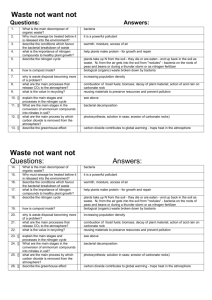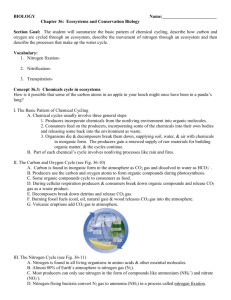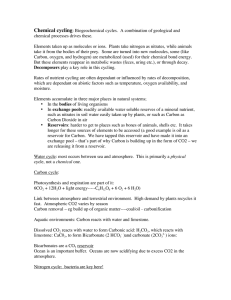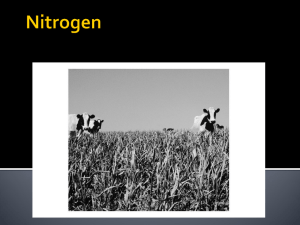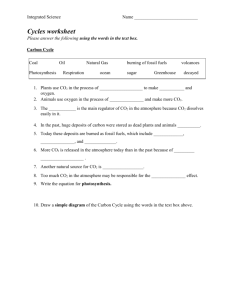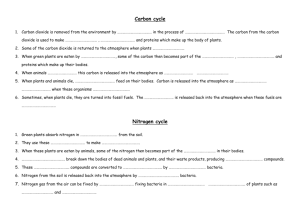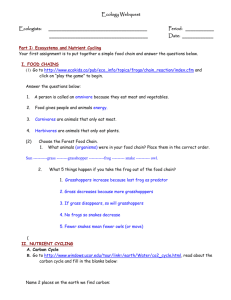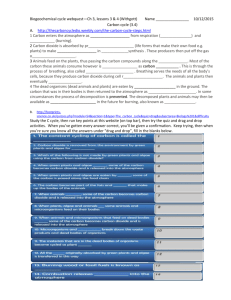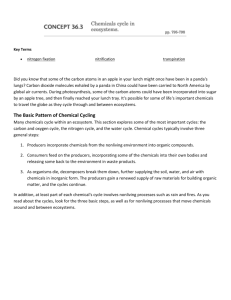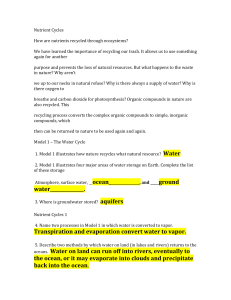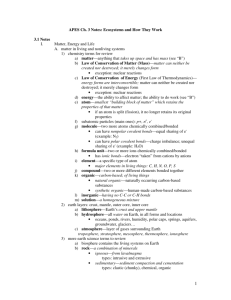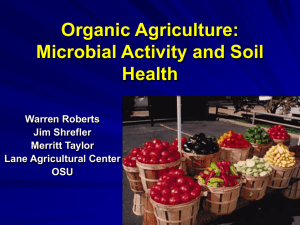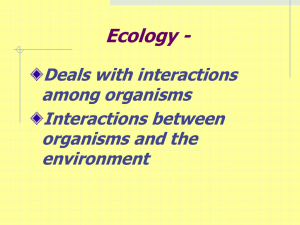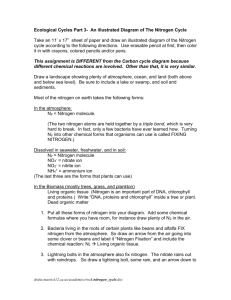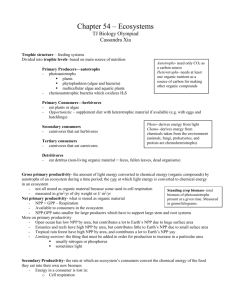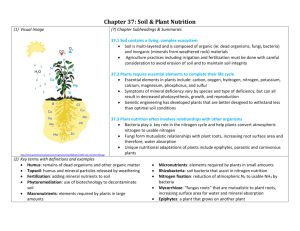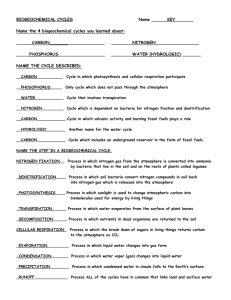Nitrogen Cycle Presenter: ___ Nitrogen Fixation: ___ Atmosphere
advertisement
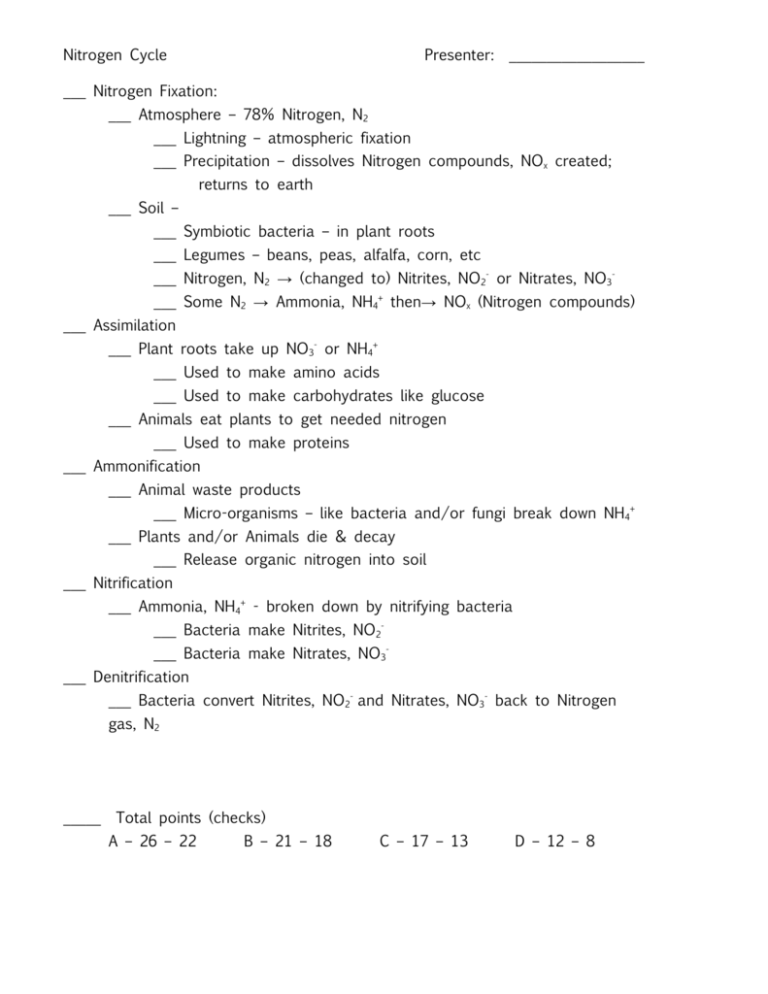
Nitrogen Cycle Presenter: __________________ ___ Nitrogen Fixation: ___ Atmosphere – 78% Nitrogen, N2 ___ Lightning – atmospheric fixation ___ Precipitation – dissolves Nitrogen compounds, NOx created; returns to earth ___ Soil – ___ Symbiotic bacteria – in plant roots ___ Legumes – beans, peas, alfalfa, corn, etc ___ Nitrogen, N2 → (changed to) Nitrites, NO2- or Nitrates, NO3___ Some N2 → Ammonia, NH4+ then→ NOx (Nitrogen compounds) ___ Assimilation ___ Plant roots take up NO3- or NH4+ ___ Used to make amino acids ___ Used to make carbohydrates like glucose ___ Animals eat plants to get needed nitrogen ___ Used to make proteins ___ Ammonification ___ Animal waste products ___ Micro-organisms – like bacteria and/or fungi break down NH4+ ___ Plants and/or Animals die & decay ___ Release organic nitrogen into soil ___ Nitrification ___ Ammonia, NH4+ - broken down by nitrifying bacteria ___ Bacteria make Nitrites, NO2___ Bacteria make Nitrates, NO3___ Denitrification ___ Bacteria convert Nitrites, NO2- and Nitrates, NO3- back to Nitrogen gas, N2 _____ Total points (checks) A – 26 – 22 B – 21 – 18 C – 17 – 13 D – 12 – 8 Carbon Cycle Presenter: __________________ ___ Carbon makes up Life, organic/biotic matter ___ Atmosphere – contains Carbon Dioxide, CO2 ___ Plants’ leaves take in/absorbs CO2 ___ Plants perform Photosynthesis ___ Photosynthesis – plants take in water and CO2 use the sun’s energy to convert to carbohydrates/glucose and release Oxygen, O2 ___ Autotrophs – convert CO2 from air to organic compounds ___ Living Organisms/consumers ___ Large area of producers store excess Carbon for long period of time ___ Eat/consume plants to get carbohydrates ___ Respire/respiration returns CO2 to atmosphere ___ Heterotrophs consume plants to return CO2 to air ___ Dead organisms release Carbon, C into ground ___ Stored as biomass in roots of trees ___ Stored in Sedimentary rocks, such as limestone ___ Long term storage becomes fossil fuels ___ Organic matter becomes humus, used by plants ___ Nonliving/Abiotic ___ Forest fire, lightning strike, not manmade; releases Carbon stored in plants/trees ___ Volcanic eruptions can release deeply buried carbon into atmosphere ___ Ocean water – absorbs and stores carbon dioxide ___ Causes water to become acidic ___ forms Carbonic acid, HCO3 ___ Carbonate, CO23- or bicarbonate ions, HCO3- are released into atmosphere as sun’s energy converts them ___ Calcium Carbonate, CaCO3 in water is used by corals and oysters for shells _____ Total points (checks) A – 22 – 18 B – 17 – 11 C – 10 – 8 D – 7 – 5 Phosphorus Cycle Presenter: ________________ ___ No Atmospheric cycle ___ Essential nutrient for plants and animals ___ Found in Soil and Rocks, ___ as a phosphate ion, (PO4)3___ Weathering – erosion from wind and/or water ___ release phosphorus, P, ___ in water, because soluble ___ in the soil, P is taken up by the plants roots ___ transformed into organic compounds ___ eaten by herbivores ___ Plants and Animals die ___ Decay releases P into soil ___ transformed into insoluble compounds ___ water causes P to runoff into waterways; streams, creeks, lakes, ponds, ocean, etc. ___ Living/Biotic organisms need P ___ PO4 is used to make nucleotides ___ energy storage within the ATP of the cells ___ form nucleic acids – DNA/RNA ___ responsible for cell development ___ form biomolecules for Bones, Teeth, Exoskeletons, Phospholipid (membranes of cells), responsible for Homeostasis ___ Calcium Phosphate, Ca3(PO4)2 is the compound used ___ Nonliving/Abiotic ___ Mineral Ca5(PO4)3OH called Apatite ___ Precipitation – causes leaching and erosion ___ Dissolution called Carbonation; releases into soil ___ Plants and Fungi breakdown ___ Absorbed by Iron Oxides, Fe2O3, Aluminum Hydroxides, Al(OH)3, clay surfaces and organic matter _____ Total points (checks) A – 25 – 20 B – 19 – 15 C – 14 – 11 D – 10 – 6 Water Cycle Presenter: __________________ ___ Also called the Hydrologic Cycle ___ Has four main stages: ___ Evaporation ___ Sun’s energy causes water to change from liquid to gas ___ physical change from liquid to gas ___ Occurs in plants ___ called Transpiration ___ Occurs in animals ___ called Perspiration ___ Condensation ___ As water molecules lose energy change from gas to liquid ___ Molecules collide with dust particles in atmosphere to form clouds ___ Water molecules collect together form clouds ___ Water molecules stick together because of cohesive and adhesive forces between the molecules ___ Precipitation ___ As molecules continue to collect, gravity cannot support the weight and the liquid water falls back to earth ___ Falls to earth in forms of Snow, Sleet, Freezing rain, Rain, Hail, etc. ___ Atmospheric temperatures determine the type of precipitation ___ Majority of precipitation falls in the oceans and surface water ___ Landing on Land (where does precipitation go) ___ Runoff ___ Ground too dry OR too wet – water flows over ground and flows into stream, ponds, lakes, etc. ___ Used by Plants and Animals ___ Infiltration ___ Water penetrates soil, percolates down into underground water storage area ___ Called aquifer ___ Used by Plants and Animals _____ Total Points (checks) A – 27 – 19 B – 18 – 14 C – 13 – 10 D – 9 - 6

